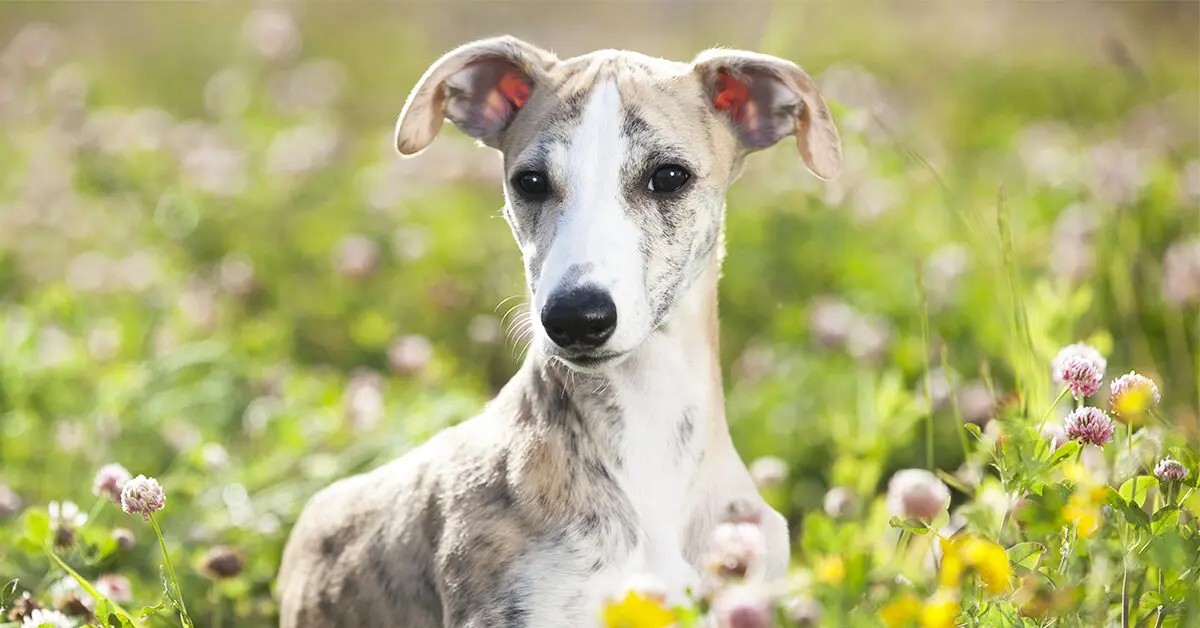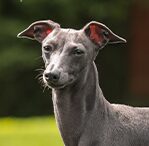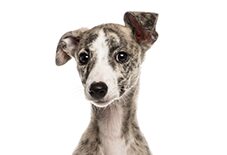
Meet the Whippet
Playful Pooch
Apartment Friendly
Calm Canine
They call me the “Poor Man’s Greyhound,” but there’s nothing subpar about me! I am a calm and affectionate picture of beauty and grace. I love cuddling up with my family on our comfy furniture and I could snooze all day if you’d let me. But when I’m not being lazy, my energy levels are moderate, so I do need some exercise. In fact, I’m like, really fast (why do you think they call me Whippet?). I’ll need a daily trip to the park for some running or some dog sports.
I’m a pretty easy going pup, and I like to be pawpular! Sure, I can get pretty attached to my family, but I don’t mind making new human (or dog!) friends. What’s more, I’m young at heart, which means I love playing with kiddos. Just don’t let me get near anything too small. I have a prey drive and can be guilty of chasing small animals around.
Ready to learn more about me? Let’s dig in.
Ready to learn more about me? Let’s dig in.
 My Many Looks
My Many Looks

Fawn

Tan

Black

Blue
 My Breed Characteristics
My Breed Characteristics
 Furbulous Fact
Furbulous Fact
Cue the puperazzi! I’m a beauty queen! We Whippets are actually some of the best performing pups in dog shows, because we’re both beautiful and athletic. Plus, our short hair makes us pretty easy to groom, so we don’t require a ton of work to prepare for the show ring. Please, please: hold the apawse!
 As I Grow Up
As I Grow Up
As you can see, we Whippets age pretty gracefully. Here are a few key milestones in my growth and development to be aware of as I grow up from a pupper to an adult and senior!

Puppy3-8 Months
Early socialization is key! I like making puppy friends, so take me to the park so I can burn some energy and play with other doggos.

Adult6 months-2 Years
As a sighthound, I’ll chase anything in motion (and fast). Make sure there’s a fenced yard or I might never find my way home.

Senior10-15 Years
As I get older, I can lose my hearing, but I usually adjust to deafness easily. And even if I can’t hear you, I still feel your love!
 History of My Breed
History of My Breed
We Whippets actually aren’t that old; our story starts no more than a couple hundred years ago. We were developed in Northern England in the late 1700s when they crossed Greyhounds with fast, long-legged Terriers, creating a new breed of sighthounds (this is why we’re sometimes called small Greyhounds or Italian Greyhounds). Poachers were the ones who used us; we’re crazy fast, so we are perfect for hunting rabbits and other small game.
But our pawesome hunting skills were used for more than just poaching. We were a breed beloved by the English working class men who used us for Whippet racing; they’d pit us against each other to test our speed or see which one of us could kill the most small animals. We’d also compete in rag racing, where we’d chase a rag on a long track that included roads and stretches of fields. We aren’t called the “Poor Man’s Racehorse” (and sometimes the “Lightning Rag Dog”) for nothing!
We came to America when working class members from Lancashire, England migrated to New England (now Massachusetts). Not to brag, but we were immediately pawpular. We were no longer just the Poor Man’s Racehorse; people from all walks of life loved watching us race. In 1888, the American Kennel Club (AKC) recognized us, and the first Whippet recognized was named Jack Dempsey after the famous boxer. And in 1899, the American Whippet club was formed!
Today, we’re still adored as fast sprinting, small dogs with a smooth coat and a cuddly side. We’re also known for our signature Whippet shivers; we don’t have much body fat, so we get cold easily and do not do well in cold weather. But above it all, we’re furbulous companions from when we’re Whippet puppies to Whippet adults. We love our family members even if we still love chasing small animals. C’mon - it’s in our blood!
 Pawesome Pups to Parent
Pawesome Pups to Parent
In addition to purebred Whippets like me, there are tons of pawfectly sweet mixed-breed Whippets that are looking to find their furever homes. You can learn where to find your next pet below!
 Care Tips
from Dr. Sarah Wooten, DVM
Care Tips
from Dr. Sarah Wooten, DVM 
Do your best to avoid injury in your Whippet.
Whippets are athletic dogs with slight frames, and are thus at higher risk for athletic injuries than sedentary dogs. Skin lacerations, muscular strains, sprains, and tears, and orthopedic injuries are common in Whippets.
Talk to your vet before any anesthetic procedure.
Whippets are sight hounds, which as a group are more sensitive to inhalant (gas) anesthesia and prone to hypothermia during anesthetic procedures. Avoid issues by discussing any concerns you have regarding anesthesia with your veterinarian.
Test your pup for deafness.
Some Whippets can be born deaf, due to a condition called congenital or hereditary deafness. Dogs like Whippets that carry the gene for merle coat color are at risk for unilateral or bilateral deafness. It is recommended to have any puppy that you want to purchase tested for hearing by your veterinarian. There is no cure for hereditary deafness.
 Training Tips
from Richard Lovejoy, Professional Remote Dog Trainer
Training Tips
from Richard Lovejoy, Professional Remote Dog Trainer

Invite your Whippet onto furniture.
Instead of picking your Whippet pup up to take them to furniture, invite them up onto furniture. You should have some control over cuddling on furniture, otherwise they’ll feel like the couch and bed are theirs and they won’t have to listen to you. Don’t let them cuddle with you on everything, although you may feel the urge to. There have to be boundaries somewhere.
Interrupt your Whippet when they’re in “predatory mode.”
Whippets are born hunters of small prey, and they’re fast sprinters. They have a lot of energy and a strong predatory instinct, so it’s easy for them to fall into cycles of wanting to hunt things. Watch for the “predatory look” when you’re out with your dog, which is when a dog pauses, focuses on an animal, and hunches over. Interrupt your dog when they’re doing that and remove them from the situation.
Set a feeding routine – and stick to it.
Keeping a healthy and functional food routine is a great way to provide consistency and instill confidence in your growing pup. Whippets also respond well to positive reinforcement, so as a reward for good behaviors during training, try taking a quarter of the kibble for the day and hand-feeding your pup throughout the day. Your puppy will still get the same amount of food by the end of the day, but now it’s bonding and learning to listen to you while receiving consistent training and food.

 Why Get Dog Insurance?
from Pumpkin®
Why Get Dog Insurance?
from Pumpkin®
While Whippets are a generally healthy breed, unexpected ruh-rohs can happen to any dog at any age. If your pup gets hurt or sick, pet insurance can help you say ‘yes’ to the best care, even when it’s costly. When it comes to shopping for this breed, you’ll want to choose insurance plans like Pumpkin's, which can help cover the costs associated with the hereditary conditions Whippets are prone to developing. While a reputable breeder will conduct genetic testing on your pup’s parents to help minimize the chances of passing down hereditary conditions, they can’t always be avoided. Let’s look at some common ones, and how Pumpkin Dog Insurance plans could help cover the cost of care!
 Hypothyroidism
Hypothyroidism
The thyroid gland in the neck makes a hormone that controls metabolism (the process of turning food into fuel). With hypothyroidism, the gland doesn’t make enough of that hormone, which can cause dry skin and coat, weight gain, and more. It’s common in adult dogs and senior Whippets.
- Cost to Treat
- $218-$384
- Pumpkin Pays Back*
- $197-$295
 Cataracts
Cataracts
Adult whippets are prone to genetic eye conditions, including cataracts. These opacities that form on the lens of the eye can show up as early as age 2, or more commonly in aging adults. Depending on the rate of progression, vision impairment may be mild, or severe and call for costly surgery.
- Cost to Treat
- $2,600-$3,800 (surgical)
- Pumpkin Pays Back*
- $2,340-$3,420
 Patellar Luxation
Patellar Luxation
Whippets are genetically predisposed to patellar luxation, in which the kneecap (patella) is dislocated from its natural position in the groove of the femur (thigh bone). This condition can greatly affect mobility, and while some cases are mild, others are severe and require corrective surgery.
- Cost to Treat
- $1,500-$7,000 (surgical)
- Pumpkin Pays Back*
- $1,350-$6,300
 Lymphoma
Lymphoma
This cancer usually starts in the lymph nodes, spleen, or bone marrow. Signs include tiredness, appetite & weight loss, and swelling of the face & legs. While sometimes fatal, some forms of Lymphoma respond well to chemo. Whippets are particularly prone to cancer starting at a younger age.
- Cost to Treat
- $3,500-$4,500
- Pumpkin Pays Back*
- $3,150-$4,050
*Example illustrates reimbursement of a covered vet bill at a 90% reimbursement rate, where the annual deductible had already been satisfied and the annual limit had not yet been met. Coverage and reimbursement results vary based on policy options.




